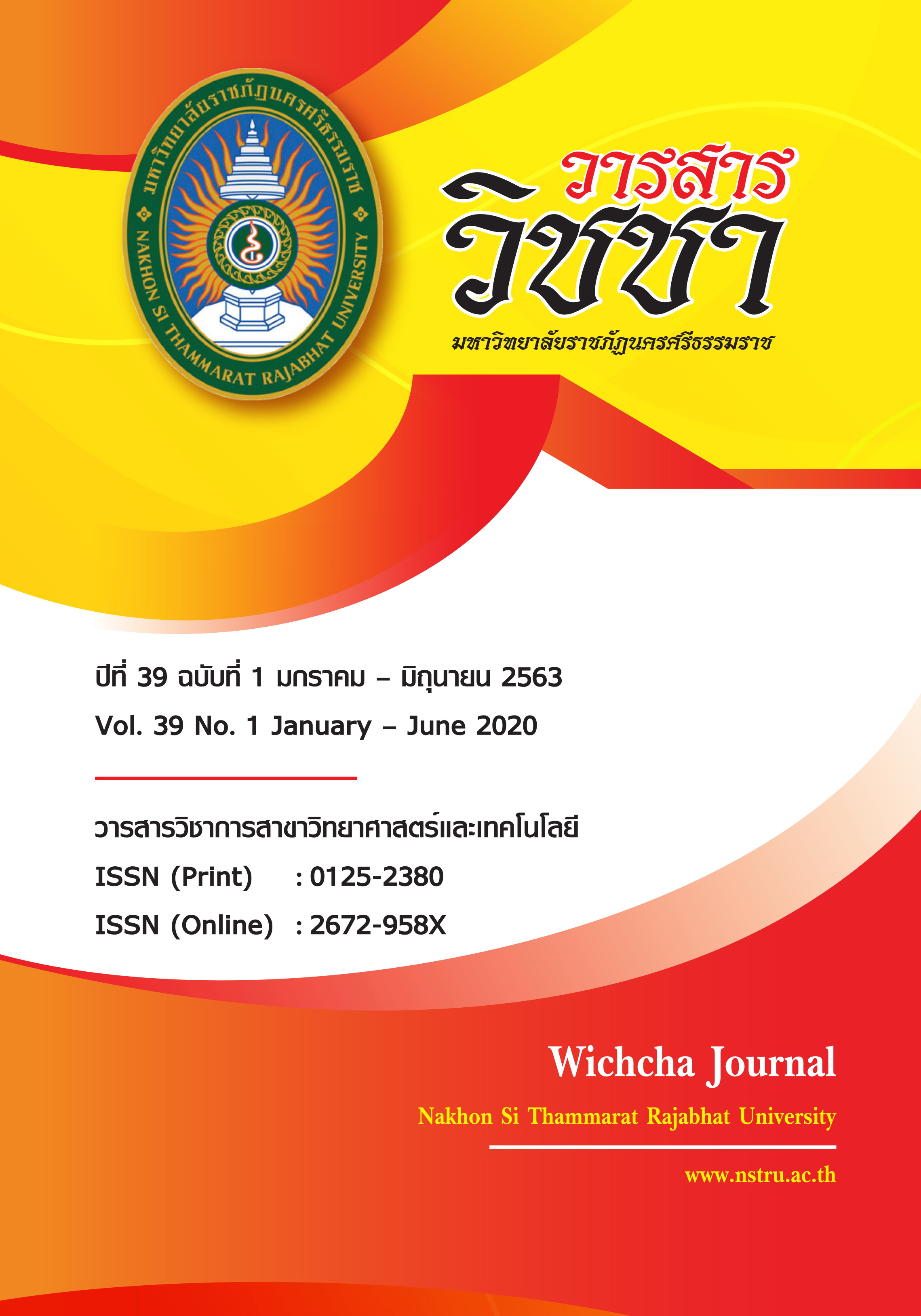Financial Return Assessment of Solar Power Plant under Subsidy Policy by Thai Government การประเมินผลตอบแทนทางการเงินของโรงไฟฟ้าพลังงานแสงอาทิตย์ ภายใต้นโยบายสนับสนุนส่วนเพิ่มอัตราการรับซื้อไฟฟ้าโดยภาครัฐ
Main Article Content
Abstract
Over the next 20 years, Thailand wants to increase the amount of electricity generation capacity from the solar energy from 2,663 MW in 2018 to 15,574 MW in 2037. Therefore, the Thai government has attempted to increase its capacity from solar energy by promoting subsidy programs including Adder program (old policy) and Feed in Tariff (FiT) program (current policy). The objective of this research was to examine the efficiency of subsidy programs used in Thailand by comparing the project financial return including net present value (NPV), internal rate of return (IRR), and payback period (PB). The results showed that the most cost-effective mechanism is the FiT program because it provided the profitable financial return while spending less money from the government subsidy than that of Adder program. Under FiT program, the NPV, IRR and PB of 1 MW solar power plant were 10,767,026 baht, 9 percent and 10 years 1 month, respectively, with governmental subsidy about 73,495,017 baht.
Article Details
เนื้อหาและข้อมูลในบทความที่ลงตีพิมพ์ในวารสารวิชชา มหาวิทยาลัยราชภัฏนครศรีธรรมราช ถือเป็นข้อคิดเห็นและความรับผิดชอบของผู้เขียนบทความโดยตรง ซึ่งกองบรรณาธิการวารสารไม่จำเป็นต้องเห็นด้วยหรือร่วมรับผิดชอบใด ๆ
บทความ ข้อมูล เนื้อหา รูปภาพ ฯลฯ ที่ได้รับการตีพิมพ์ในวารสารวิชชา มหาวิทยาลัยราชภัฏนครศรีธรรมราช ถือเป็นลิขสิทธ์ของวารสารวิชชา มหาวิทยาลัยราชภัฏนครศรีธรรมราช หากบุคคลหรือหน่วยงานใดต้องการนำข้อมูลทั้งหมดหรือส่วนหนึ่งส่วนใดไปเผยแพร่ต่อหรือเพื่อการกระทำการใด ๆ จะต้องได้รับอนุญาตเป็นลายลักษณ์อักษรจากวารสารวิชชา มหาวิทยาลัยราชภัฏนครศรีธรรมราชก่อนเท่านั้น
The content and information in the article published in Wichcha journal Nakhon Si Thammarat Rajabhat University, It is the opinion and responsibility of the author of the article. The editorial journals do not need to agree. Or share any responsibility.
References
กรมพัฒนาพลังงานทดแทนและอนุรักษ์พลังงาน. (2558). แผนพัฒนาพลังงานทดแทนและพลังงานทางเลือก พ.ศ. 2558-2579 (AEDP2015). สืบค้นเมื่อ 5 เมษายน 2563, จาก: http://www.eppo.go.th/index.php/th/plan-policy/tieb/aedp.
กรมพัฒนาพลังงานทดแทนและอนุรักษ์พลังงาน. (2561). รายงานสถานการณ์การผลิตไฟฟ้าจากพลังงานแสงอาทิตย์ของประเทศไทย พ.ศ. 2559-2560. สืบค้นเมื่อ 16 เมษายน 2563, จาก: http://webkc.dede.go.th/testmax/sites/default/files/Book%20TPSR%20THAI.pdf.
กระทรวงพลังงาน. (2558). แผนปฏิบัติการพัฒนาพลังงานทดแทนและพลังงานทางเลือก พ.ศ. 2558-2579. สืบค้นเมื่อ 5 เมษายน 2563, จาก: https://www.dede.go.th/download/files/AEDP%20Action%20Plan_Final.pdf.
ชาณิกา ปัญจพุทธานนท์ และรัตพงษ์ สอนสุภาพ. (2559). ปัญหาและอุปสรรคของการพัฒนาพลังงานไฟฟ้าจากแสงอาทิตย์ในประเทศไทย. วารสารวิจัยและพัฒนา วไลยอลงกรณ์ ในพระบรมราชูปถัมภ์, 11(3), 11-20.
ธนาพล ตันติสัตยกุล. (2558). การประเมินมาตรการสนับสนุนทางการเงินสาหรับระบบผลิตไฟฟ้าพลังงานแสงอาทิตย์บนหลังคาที่พักอาศัยในประเทศไทย. วารสารวิทยาศาสตร์และเทคโนโลยี, 23(4), 605-621.
บดินทร์ เสนานนท์ กัญญานัฐ ทองเทพ กมล จิรเสรีอมรกุล วันจักรี์ เล่นวารี เสริมสุข บัวเจริญ และ ยิ่งรักษ์ อรรถเวชกุล. (2562). การวิเคราะห์เศรษฐศาสตร์โรงไฟฟ้าพลังงานแสงอาทิตย์ 8
เมกะวัตต์ ระหว่างการติดตั้งแบบระบบคงที่กับแบบระบบติดตามดวงอาทิตย์ในประเทศไทย. วารสารวิชาการมหาวิทยาลัยราชภัฏอุตรดิตถ์, 14(2), 1-19.
ปฐมทัศน์ จิระเดชะ. (2553). การพัฒนาพลังงานหมุนเวียนเพื่อการผลิตไฟฟ้าในประเทศไทย. วารสารมหาวิทยาลัยศรีนครินทรวิโรฒ (สาขาวิทยาศาสตร์และเทคโนโลยี), 4(2), 10-24.
พวงทอง วังราษฎร์ วราภรณ์ สิงห์แก้วสืบ และสายนที ทรัพย์มี. (2562). การวิเคราะห์ต้นทุนและผลตอบแทนโครงการลงทุนผลิตกระแสไฟฟ้าจากเซลล์แสงอาทิตย์. วารสารมหาวิทยาลัยราชภัฏลำปาง, 7(2), 89-100.
สำนักงานนโยบายและแผนพลังงาน. (2562). แผนพัฒนากำลังผลิตไฟฟ้าของประเทศไทย พ.ศ. 2561-2580 (PDP2018). สืบค้นเมื่อ 5 เมษายน 2563, จาก: http://www.eppo.go.th/images/Infromation_service/public_relations/PDP2018/PDP2018.pdf.
อรรถพล เตวัฒนรัตน์. (2558). การศึกษาความเป็นไปได้ในการลงทุนโรงไฟฟ้าพลังงานแสงอาทิตย์ ขนาด 1 เมกะวัตต์. วิทยานิพนธ์เศรษฐศาสตรมหาบัณฑิต. มหาวิทยาลัยธุรกิจบัณฑิต, กรุงเทพมหานคร.
Boomsma, T.K., Meade, N. and Fleten, S.E. (2012). Renewable energy investments under different support schemes: A real options approach. European Journal of Operational Research, 220(1), 225-237.
Cory, K., Couture, T. and Kreyci, C. (2009). Feed-In Tariff policy: design, implementation, and RPS policy interactions. National Renewable Energy Laboratory’s Technical Report. Colorado.
Chaichana, P., Womgsapai, W., Damrongsak, D., Keiichi, K. and Luangchosiri, N. (2017). Promoting community renewable energy as a tool for sustainable development in rural areas of Thailand. Energy Procedia, 141, 114-118.
Chimres, N. and Wongwises, S. (2016). Critical review of the current status of solar energy in Thailand. Renewable and Sustainable Energy Reviews, 58, 198-207.
Mitchell, C. and Connor, P. (2012). Renewable energy policy in the UK 1990-2003. Energy Policy, 32, 1935-1947.
Peerapong, P. and Limmeechokchai, B. (2014). Investment incentive of grid connected solar photovoltaic power plant under proposed feed-in tariffs framework in Thailand. Energy Procedia, 52, 179-189.
Pita, P., Tia, W., Suksuntornsiri, P., Limpitipanick, P. and Limmeechockchai, B. (2015). Assessment of feed-in policy in Thailand: Impacts on national electricity prices. Energy Procedia, 79, 584-589.
Sampim, T. and Kokkaew, N. (2013). Modelling of government support in biopower plant projects: The case of Thailand. Energy Procedia, 52, 525-535.
Sampim, T. and Kokkaew, N. (2017). Risk management in biomass power plants using fuel switching flexibility. Energy Procedia, 138, 1099-1104.
Tongsopit, S. (2015). Thailand’s feed-in tariff for residential rooftop solar PV systems: Progress so far. Energy for Sustainable Development, 29, 127-134.
Tongsopit, S., Junlakarn, S., Wibulpolprasert, W., Chaianong, A., Kokchang, P. and
Nghia, V.H. (2019). The economics of solar PV self-consumption in Thailand. Renewable Energy, 138, 395-408.


